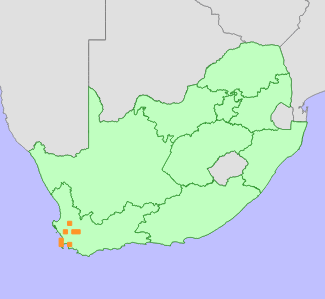|
Scientific Name | Disa physodes Sw. |
Higher Classification | Monocotyledons |
Family | ORCHIDACEAE |
Synonyms | Monadenia physodes (Sw.) Rchb.f. |
National Status |
Status and Criteria | Critically Endangered C2a(i) |
Assessment Date | 2012/09/01 |
Assessor(s) | L. von Staden, B. Bytebier, W.R. Liltved, E.G.H. Oliver & T.A. Oliver |
Justification | A predominantly lowland species that has lost more than 90% of its habitat to urban and agricultural expansion. Known from four subpopulations, all with fewer than 50 mature individuals. The total population is estimated to be under 100 mature individuals, and continues to decline due to ongoing habitat loss and fragmentation. Fire exclusion from small, isolated fragments is the most severe threat to this fire-dependent species. |
Distribution |
Endemism | South African endemic |
Provincial distribution | Western Cape |
Range | Formerly occurred from Piketberg to the Cape Peninsula, currently restricted to the area between Wellington and Ceres. |
Habitat and Ecology |
Major system | Terrestrial |
Major habitats | Swartland Shale Renosterveld, Breede Shale Renosterveld, Ceres Shale Renosterveld, Peninsula Shale Renosterveld, Swartland Granite Renosterveld, Breede Shale Fynbos, Peninsula Granite Fynbos |
Description | Well-drained shale and granite flats and lower slopes. |
Threats |
| This formerly widespread species (historical EOO 6623 km²) has declined extensively as a result of loss of more than 90% of its habitat, predominantly to crop cultivation but also urban expansion. This fire-dependent species is now confined to small, isolated fragments where fires are generally excluded - resulting in local extinctions. Only one subpopulation occurs within a private nature reserve, while the rest are threatened by ongoing habitat loss to agricultural and industrial expansion as well as competition from alien invasive plants. |
Population |
Disa physodes has become extremely rare due to habitat loss and fragmentation, and was at one point thought to be extinct. Recently, four subpopulations have been discovered in lowland renosterveld remnants in the Wellington-Ceres area: About 20 plants occur on a farm near Wolseley and is threatened by agricultural expansion, while another small population of about 20 plants was rediscovered at an industrial site near Ceres in 2011, after plants were last seen in 1993. A third subpopulation of about 10 plants was found on a severely degraded fragment north of Ceres in 2011, after the species was last recorded in this area in 1973. Two plants were seen in a private nature reserve after a fire in 2008.
|
Population trend | Decreasing |
Assessment History |
Taxon assessed |
Status and Criteria |
Citation/Red List version | | Disa physodes Sw. | CR C2a(i) | Raimondo et al. (2009) | | Disa physodes Sw. | VU D2 | Victor (2002) | | Monadenia physodes (Sw.) Rchb.f. | Endangered | Hilton-Taylor (1996) | | Monadenia physodes (Sw.) Rchb.f. | Indeterminate | Hall et al. (1980) | |
Bibliography |
Hall, A.V., De Winter, M., De Winter, B. and Van Oosterhout, S.A.M. 1980. Threatened plants of southern Africa. South African National Scienctific Programmes Report 45. CSIR, Pretoria.
Hilton-Taylor, C. 1996. Red data list of southern African plants. Strelitzia 4. South African National Botanical Institute, Pretoria.
Liltved, W.R. and Johnson, S.D. Unpublished. The Cape Orchids - Wild orchids of the Cape Floral Kingdom.
Linder, H.P. 1981. Taxonomic studies in the Disinae. V. A revision of the genus Monadenia. Bothalia 13(3&4):339-363.
Linder, H.P. 1999. Disa. In: H.P. Linder and H. Kurzweil (eds.), Orchids of southern Africa (pp. 187-288), A.A. Balkema, Rotterdam.
Raimondo, D., von Staden, L., Foden, W., Victor, J.E., Helme, N.A., Turner, R.C., Kamundi, D.A. and Manyama, P.A. 2009. Red List of South African Plants. Strelitzia 25. South African National Biodiversity Institute, Pretoria.
Victor, J.E. 2002. South Africa. In: J.S. Golding (ed), Southern African plant Red Data Lists. Southern African Botanical Diversity Network Report 14 (pp. 93-120), SABONET, Pretoria.
|
Citation |
| von Staden, L., Bytebier, B., Liltved, W.R., Oliver, E.G.H. & Oliver, T.A. 2012. Disa physodes Sw. National Assessment: Red List of South African Plants version . Accessed on 2025/06/01 |
 Comment on this assessment
Comment on this assessment


